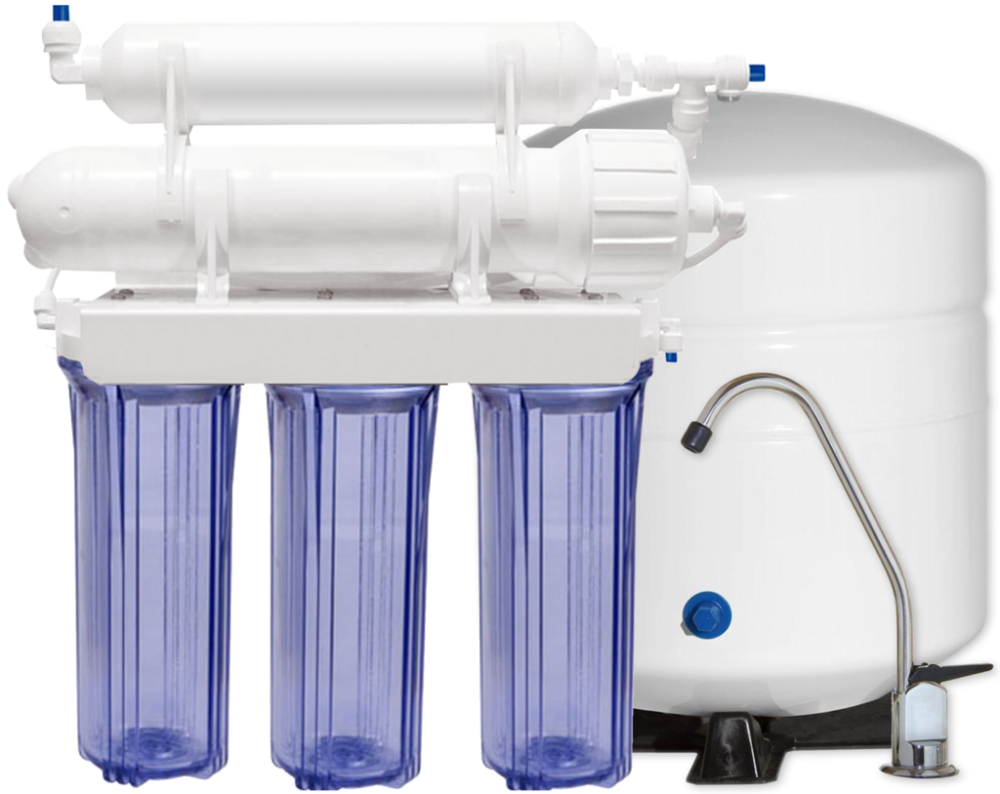Among skeptics of reverse osmosis in water treatment, much ado is made about the filtration method’s potential impacts on the environment. You may have heard statistics about how it filters “waste” roughly four gallons of water for every gallon they produce.
But are these statistics misleading? Is it terrible for the environment? Let’s dive into these questions.
Reverse Osmosis Explained
“D” represents the membranes, with B and E representing “waste” and clean water, respectively.
To get an understanding of reverse osmosis’ environmental impact, you must understand how it works.
Reverse osmosis uses pressure to force water through progressively more delicate membranes. Some of these membranes are even finer than a human hair! Contaminants are too large to pass through these membranes, which means water that makes it out of the filter can be as much as 99% pure.
That is, of course, the abridged version of the process. Read more about it via this handy guide from themiraclemachine.net
Reverse Osmosis in Water Treatment: What Is Wastewater?
No matter how efficient your system is, it will produce wastewater. However, several factors can lead to increased wastewater production. Water pressure is the primary of these factors; higher weight equates to more efficient filtration, while pressure under 40 psi typically only produces wastewater.
This wastewater is characterized by high concentrations of impurities, meaning it is unsafe to drink or use for bathing.
To call it wastewater is a bit deceptive, however. The reason for this is twofold. We’ll explore each in the next section.
Why Reverse Osmosis Systems Don’t “Waste Water.”

Image source: shopify.com
Reason 1: The “Wastewater” Is Essential To The Filter’s Function
You’ll recall that in our “Reverse Osmosis: Explained” section, we mentioned that these filters use force to pass your water through a series of membranes. Well, that force doesn’t just exist on its own! This system needs additional water to facilitate the process.
Would you describe bathing as “wasting water?” Probably not, since swimming is essential (hopefully you agree) and you can’t do it without water.
The same is true for such systems. They can’t perform their essential function without using (not wasting) water.
Reason #2: The “Wastewater” Doesn’t Get Thrown Out
Many of these filters divert the wastewater into a tank. While this water is exceptionally high in contaminants (known as total dissolved solids, or TDS) and, therefore, unsuitable for drinking or bathing, people commonly use it for a variety of purposes. These include:
- washing their car
- cleaning around the house (mopping floors, etc.)
- washing clothes (you can feed it directly to your washing machine)
- flushing toilets
- hydroponics
These are all activities that would traditionally require “new” water from your faucet or a hose. By using your system’s reject water for these tasks instead, you’ll save on two fronts. First, you’ll put the “wastewater” to good use. Second, you’ll avoid having to use additional water for the tasks mentioned above.
Bonus Reason #3: The Alternative Is Much Worse
Even if the worst-case-scenario parroted by skeptics were true (that is, reverse osmosis wastewater is lost forever), this would still be preferable from an environmental standpoint to the alternative of drinking water from plastic bottles.
The plastic water bottle industry is one of the most environmentally disastrous. It causes significantly more damage to the environment (and your wallet, for that matter) than using a filter.
While many skeptics are also quick to point out that reverse osmosis water is terrible for you to health-wise due to its absence of minerals (read more against this argument here), this is also untrue. Your body gets most of its mineral intake from dietary sources. Losing some of it in your water isn’t going to be detrimental to your health.
Reverse Osmosis Environmental Impact: Other Factors

Image source: thrillist.com
Reverse osmosis is one of the essential tools humanity has for turning out abundant-yet-undrinkable oceans into potable water. While residential uses are the most oft-thought-of, it is used at broad scales too.
At these larger scales (such as in desalination plants), there are concerns about whether brine discharges may negatively impact the environment. Specifically, these TDS-rich discharges may harm aquatic wildlife.
That isn’t necessarily an issue with reverse osmosis itself but rather the way discharges — and the process as a whole — is handled at large scales. There is a technology that can limit the negative impacts of these discharges, and many plants do use it.
Further, this shouldn’t discourage you from using a system in your home. Proper disposal of the membranes when they “expire” (which is every 3-5 years) can minimize your system’s impact on the environment.
Conclusion
Reverse osmosis is one of the most effective water filtration methods available. While skeptics raise concerns about its potential for “wasting water,” these are generally overstated. These systems don’t waste water as much as they use it as part of the purification process. Secondly, this water doesn’t have to go to waste; you can use it for just about everything except drinking or bathing.
Perhaps most important, though, is the fact that reverse osmosis is considerably less damaging for the environment than the alternative of drinking bottled water.
Proper management of discharge can contain the environmental impacts of reverse osmosis, even at larger scales.
Check out waterpeople.com.au for more information on ceramic water filters


















